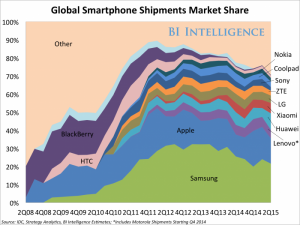This deal highlights the decline in HTC’s market share contributed to by underinvestment in marketing.
Reading time: 1.5 minutes to get the summary, or read the detail in 5 minutes.
What’s happened?
On Wednesday (20th September 2017) HTC, the Taiwanese consumer electronics company known for its smartphone devices and more recently virtual reality headsets, suspended trading in its shares, with a pending announcement that its smartphone division would be purchased by Alphabet, Google’s parent company. (This has now been confirmed, with a value of $1.1bn).
It may be smiles all round at the press conference, but many analysts queried this acquisition, because even though HTC and Google had already worked together on the Google Pixel smartphone device, HTC’s market share had fallen steadily over a number of years, from around 9% to under 1%.
It’s widely reported that two of the key factors that have led to HTC’s market share decline are:
- Poor understanding and slow reaction to customer needs in different global markets;
- Lack of marketing investment, to compete with big rivals like Samsung and Apple.
The change in HTC’s fortunes is a good example of how neglecting marketing as a key area in which to invest, can lead to more than just a few lost sales leads and sales people with too much time on their hands.
The role of a modern marketing department is to not only bring good quality new customers into the sales pipeline, but it should also be the eyes and ears, giving feedback on customer needs, challenges and wants, as well as managing the relationship between the customer and the brand, alongside account managers.
When you put in place a process to adjust and direct your business based on these customer interactions, you have far more chance of growing beyond your competitors, and this all starts with defining your Customer Journey.
Find out how to create your ideal Customer Journey.
Looking at the factors that have reportedly caused the decline of HTC’s business in more detail, you can start to understand the key role that marketing plays in delivering success.
Reaction to customer needs.
Back in 2015, Business Insider UK ran an article that highlighted the continued decline of HTC’s market share in the global smartphone market. By this point, their market share was down from 9%, to just 2%.
Business Insider UK highlighted how the other main rivals had positioned themselves very clearly in the two key growth markets. Samsung and Apple dominated the premium end of the market, in wealthier countries such as the UK and the US. Huawei and Xiaomi were winning in the emerging markets, with their mid to low end price points.
These four competitors had invested decent portions of their revenue into building strategies based on a clear understanding of global markets, detailed profiling of their ideal customers and biggest opportunities for the propositions they had to offer.
The role of marketing in helping a business define its strategy has become increasingly significant over the past 5-10 years because when considering where to point your product or service (customer segments, global markets etc) it’s now the feedback that marketing interactions are collecting through digital channels, that is most up-to-date and shows a true reflection of a specific market’s needs.
Investing in marketing.
Although HTC had made some moves into the wealthier markets, including producing Googles Pixel device, their marketing strategy was falling short, meaning they had a lack of customer interaction and the HTC brand was fading from view.
As far back as 2012, mistakes were being made.
When rivals Samsung and Apple increased their marketing budgets from the previous year (414% and 32% respectively), HTC decreased theirs by 63%.
Yes, you read that correctly: minus 63%.
Samsung’s market share increased from around 10% to about 27% in that single year, with Apple gaining another 5% of the market.
In the same period, HTC had lost a further 4% to rivals, leaving it with just 5% of the market, nearly half its 2010 market share.
This time was a critical period in the global smartphone market and stepping off the gas in terms of marketing meant that customers were focused on rivals in both the major wealthy and developi
ng markets.
Samsung used this period to demonstrate how they could also produce attractive smartphones on the Android platform, and made a big deal about innovation with their regional innovation centres, which is exactly what customers wanted to hear.
Samsung were listening to their customers through marketing and sales channels, building their business around that feedback and using their increasing brand awareness to promote their devices as the alternative to Apple.

Apple continued to focus on high-end innovation, building and maintaining strong customer relationships and using marketing to create huge hype and anticipation around every hardware and software launch.
In developing markets, Huawei and Xiaomi were addressing the mid to low end price point for smartphone devices.
Each had used a combination of deep market analysis and customer feedback through marketing channels, to develop winning strategies and products that fitted perfectly into those markets.
In 2013, HTC recognised the impact of the poor marketing investment and increase their marketing funds by 250%, but Samsung, Apple, Huawei and Xiaomi had already made major gains in creating strong customer loyalty and a large number of brand advocates.
And as this graph from Business Insider UK shows (up to end 2015), the market share growth for its competitors, and HTC’s decline, continued as a steady trend.
What about your business?
Clever competitors that are on the ball, will be looking at how they can build a growth strategy around clear understanding of a particular set of target customers.
In a fiercely competitive market, sometimes one small slip can lead to a steady decline, even if you recognise it and look to make amends.
You need to evaluate your investment in marketing and customer interaction, to make sure that you’re in a strong position to keep pace with your customer’s challenges and opportunities, and building a strong base of loyal customers, through thought leadership, clear positioning and demonstrating a deep understanding of your customers.
Spend time considering your Customer Journey.
